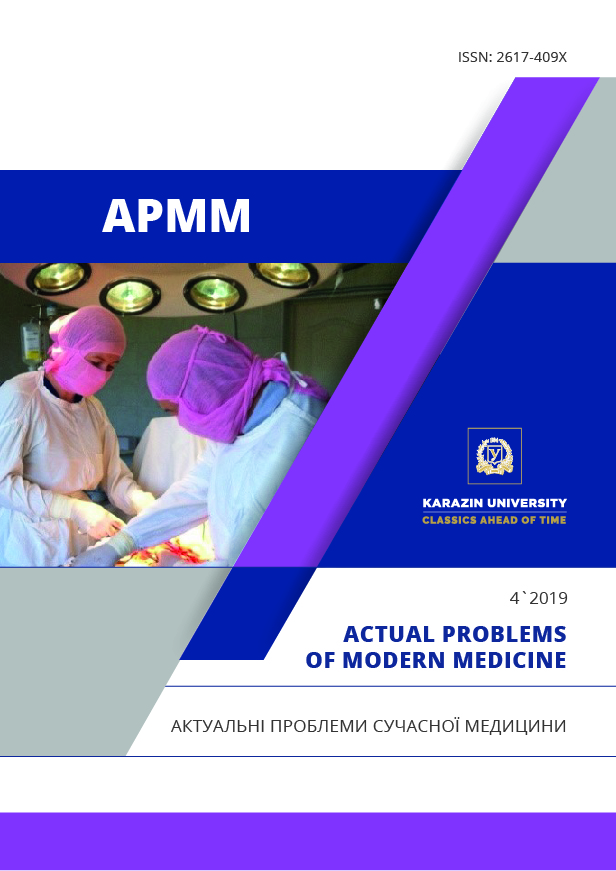The role of natural resistance factors in the development of inflammatory complications in patients with closed thoracic trauma
Abstract
Summary. In recent years, the upward trend in closed severe chest injuries has increased. Closed chest injury with fractures of the ribs is often accompanied by the occurrence of purulent-inflammatory complications. So, the ability of blood serum to lysis Escherichia coli (bactericidal activity of blood serum), micrococcus (indicator of lysozyme content), bacillus subtilis (indicator of beta-lysine content) in 54 patients with a closed chest injury was studied. The indicators of factors of natural resistance were compared with those of 40 healthy people. In addition, the indicators of patients whose trauma proceeded with and without an inflammatory complication were compared with each other. Inflammatory complications in the form of post-traumatic pleurisy and pneumonia were observed in 34 (62.9%) of the examined patients with fractures of 1-3 ribs. In patients with these injuries, we revealed a slight decrease in the bactericidal activity of blood serum: on the first day in the group of patients with a smooth flow to 75.92 + 3.22%, and in the group of patients with complication of the trauma, the inflammatory process (pleurisy, pneumonia) to 72, 83 + 2.65%. On the second day, in the first group, BABS decreases even more to 70.79 + 3.11%, and on the second day it increases to 87.32 + 1.91% (p <0.05). All subsequent days of observation, the bactericidal activity of the blood serum of patients with a favorable flow remained normal or close to normal.The concentration of serum beta-lysine in patients is also subject to large changes depending on the course of the post-traumatic period. In cases of smooth flow, on the first day we noted an increase in the content of beta-lysine in 52.87 + 2.51% (with a norm of 39.3 + 1.4%). Starting from the second day there is a clear downward trend in this indicator. From 4 to 5 days, he approaches the norm (44.32 + 2.40%) and remains within these limits throughout the entire observation period. Thus, a decrease in serum lysozyme and an increase in beta-lysine concentration from the first day after an injury in patients with fractures of 1-3 ribs can serve as a prognostic sign of an inflammatory complication.resistance, which were already registered with minor injuries. However, in cases of the development of the inflammatory process, there is a more significant decrease in the lysozyme content and an increase in the concentration of beta-lysine in the blood serum from the first day after the injury, remaining on all subsequent days.
Downloads
References
Bisenkov, L.N., Zubarev, P.N., Ischenko, B.I., Trofimov, V.M., & Shalaev, S.A. (2015). Emergency surgery of the chest and abdomen: a guide for doctors. St. Petersburg: SpetsLit. P.574. [in Russian]
Dzharkeev, KS, Irsaliev, RK, & Kushkinbaev, G.Zh. (2014). The use of videothoracoscopy in the treatment of multiple complicated rib fractures. Materials of the IV International Congress "Actual directions of modern cardio-thoracic surgery", St. Petersburg. P.162. [in Russian]
Zavrazhnov, A. A., Porkhanov, V. A., Bosco, O. Yu., Polyakov, I. S., Kovalenko, A. L., Naryzhny, N. V., & Pyatakov, S. N. . (2016). The use of the principles of surgical tactics “Damage control” in the treatment of closed injuries and injuries of the breast in peacetime. Materials of the 3rd All-Russian Conference in the framework of the 3rd Congress of Emergency Medicine Doctors (on the 125th anniversary of S.S. Yudin), Moscow. P.37-38. [in Russian]
Porkhanov, V.A., Zavrazhnov, A.A., Afaunov, A.A., Blazhenko, A.N., & Mukhanov, M.L. (2016). Analysis of factors influencing the mortality rate among patients in the acute period of polytrauma hospitalized in a regional multidisciplinary hospital. Medical Bulletin of the South of Russia. 4. P.39-44. [in Russian]
Battle, C.E., & Evans, P.A. (2015). Predictors of mortality in patients with flail chest: a systematic review. Emerg Med J. 32(12). P.961-965.
Chung, J. H., Cox, C. W., Mohammed, T. L., Kirsch, J., Brown, K., Dyer, D. S. … Suh, R. D. (2014). ACR appropriateness criteria blunt chest trauma. J Am Coll Radiol. 11(4). P.345–351.
Cotogni, P., Barbero, C., & Rinaldi, M. (2015). Deep sternal wound infection after cardiac surgery: evidences and controversies. World J Crit Care Med. 4(4). P.265-273.
Galie, N., Humbert, M., Vachiery, J.L., Gibbs, S., Lang, I., Torbicki, A. … Hoeper, M. (2016). 2015 ESC/ERS Guidelines for the diagnosis and treatment of pulmonary hypertension. The Joint Task Force for the Diagnosis and Treatment of Pulmonary Hypertension of the European Society of Cardiology (ESC) and the European Respiratory Society (ERS). Endorsed by: Association for European Paediatric and Congenital Cardiology (AEPC), International Society for Heart and Lung Transplantation (ISHLT). Eur. Heart J. 37(1). P.67-119.
Garcia Villar, C., Sagarra Lozano, A.M., & Japon Sola, F. (2014). Pneumomediastinum and subcutaneous emphysema due to ribs fractures. Med Clin. 143(1). P.48.
Schulz-Drost, S., Oppel, P., Grupp, S., Krinner, S., Langenbach, A., Lefering, R., & Mauerer, A. (2016). Bony injuries of the thoracic cage in multiple trauma: incidence, concomitant injuries, course and outcome. Unfallchirurg. 119(12). P.1023-1030.




